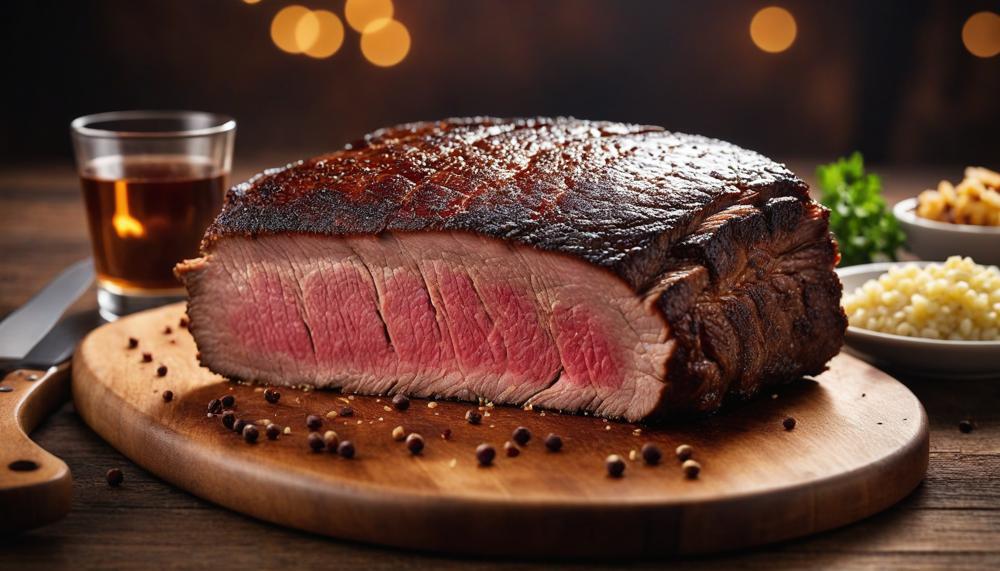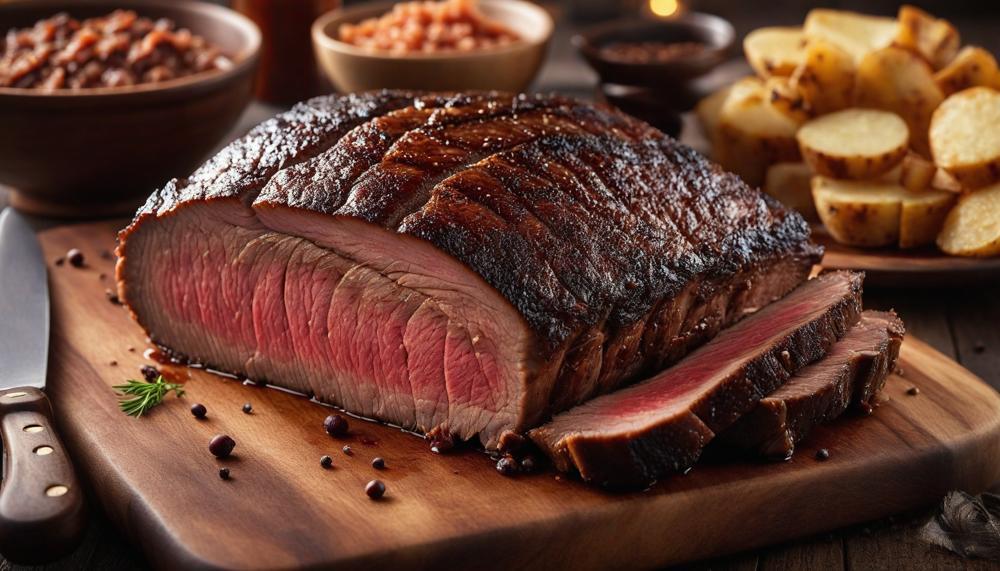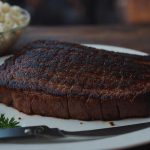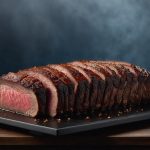Have you ever savored a perfectly smoked brisket and wondered just how long that succulent piece of meat was allowed to rest before being served? The answer to whether a brisket can sit for 5 hours after cooking boils down to a confident “Yes,” but with some crucial caveats centered around food safety and quality retention.
When it comes to resting brisket, or any large cut of smoked meat, understanding the dynamics of temperature and time is key. While a minimum rest period of 30 minutes is often quoted, those in the know appreciate that for a large cut like brisket, one to two hours can be even more beneficial. The real magic happens when the juices redistribute throughout the meat, making each bite as tender and moist as the last. However, maintaining a safe internal temperature of at least 140°F during this time is non-negotiable to prevent any potential for bacterial growth and spoilage.
Many barbecue aficionados and professional pitmasters will even hold briskets at safe temperatures for 2-4 hours to align with service times, using tools like warm ovens or restaurant-grade heated food storage units. Here’s why adhering to these practices can make or break your brisket experience:
- Temperature Control: Keeping the brisket above 140°F is critical to prevent bacteria and ensure the meat remains safe to eat.
- Quality and Taste: Proper resting allows flavors to deepen and the meat to retain its moisture, enhancing the overall eating experience.
- Practical Considerations: In a professional setting, extended holding times accommodate service needs without sacrificing food safety.
The debate about resting times for brisket reflects broader principles in culinary science and food safety. Balancing these can help you achieve that perfect brisket experience, whether you’re a backyard BBQ enthusiast or a professional chef.
Remember, the key to a great brisket lies not just in how it’s cooked, but also in how it’s rested and held.
Contents
Can Brisket Rest Too Long?
Yes, brisket can indeed rest for too long. The ideal resting period for a brisket is critical for achieving the perfect balance of moisture and texture. Here’s a detailed look at why brisket can rest too long and what happens when it does.
When brisket is cooked and then allowed to rest, the purpose is to let the juices redistribute throughout the meat. This process ensures that every bite is succulent and tender. However, if the brisket rests beyond the recommended period, typically between one to two hours, it can start to cool down too much, leading to a loss of the desired warm texture and can make the meat firm.
Additionally, maintaining a safe temperature during the resting phase is crucial. The brisket should stay above 140°F to prevent the growth of harmful bacteria. If the meat’s temperature drops below this threshold for a prolonged period, it can become unsafe to eat. Here’s how you can manage the resting period effectively:
| Time | Temperature | Method |
| 1-2 hours | Above 140°F | Resting in a warmer or faux Cambro |
| Exceeding 2 hours | Risks dropping below 140°F | Not recommended without temperature control |
| 2-4 hours (controlled) | Maintained above 140°F | Using a low oven or commercial warmer |
By keeping brisket within these guidelines, you can ensure that it remains delicious and safe to eat. It’s best to plan your cooking schedule to avoid over-resting the meat and to employ methods like a faux Cambro or a low oven to keep it warm if you aren’t serving it immediately.
The Importance of Resting
Resting a brisket for five hours before serving or slicing has profound benefits on its quality and enjoyment. Let’s delve into the various advantages:
| Juice Redistribution | Resting allows the juices to settle back into the fibers of the brisket. This process prevents the juices from escaping when slicing, maintaining the brisket’s moisture and tenderness. |
| Collagen Reformation | As the brisket cools, the collagen that has dissolved during cooking begins to firm up. This thickens the meat’s natural juices, keeping them within the meat and enhancing its flavor and succulence. |
| Steam Retention | Keeping the brisket intact without slicing it right away helps to lock in the steam. This retention of steam preserves the internal moisture of the meat, making it juicier and more flavorful. |
| Moisture Preservation | Research indicates that a brisket immediately sliced post-cooking can lose a significant amount of moisture. A five-hour rest greatly diminishes this loss, reducing it to less than one tablespoon of liquid. |
| Texture Improvement | Resting allows the meat’s muscle fibers to relax and retain their tenderness, particularly important for the flat end of the brisket, which contains less fat and is prone to dryness. |
| Serving Timing | If the brisket needs to be served immediately after cooking, it should still rest for a minimum of one hour. For later serving, extending this rest to two or more hours ensures optimal taste and texture. |
In summary, allowing a brisket to rest for an extended period like five hours ensures the meat is not only delicious with enhanced flavors but also tender and juicy, providing a superior eating experience.
How Long Should Brisket Rest?
The short answer is: at least one to two hours. For the best results, aim for a rest time of 2-3 hours. If you can manage, resting for 4-6 hours ensures even better flavour and tenderness.
Resting brisket is not merely a waiting game; it’s a critical step to ensure your hard-earned smoked meat turns out perfectly. When you rest brisket, the internal juices redistribute throughout the meat, which makes every bite moist and flavourful. Neglecting this step can lead to a dry, less enjoyable texture.
Here’s a quick guide to help you:
| Resting Time | Benefits | Method |
| 1-2 Hours | Basic juice redistribution, improved moisture | Wrap in aluminum foil or butcher paper, place in cooler |
| 2-3 Hours | Better flavour, tenderness, and moisture retention | Wrap brisket, place in cooler lined with a towel |
| 4-6 Hours | Optimal texture, full flavour development, ultimate tenderness | Wrap brisket, place in cooler or heated storage unit |
Why Rest Brisket?
Resting allows the brisket’s juices to be reabsorbed into the meat fibers, preventing them from spilling out when you slice it. This process ensures a tender, succulent texture.
Moreover, it keeps the brisket warm enough to serve without entering the danger zone (40°-140°F) where bacteria can grow.
How to Rest Brisket:

- Wrap: After smoking, wrap the brisket in aluminum foil or butcher paper to retain heat.
- Insulate: Cover the wrapped brisket with a towel.
- Store: Place the wrapped and insulated brisket in a cooler. This acts as a makeshift warmer, preserving the heat for several hours.
For longer resting periods, commercial BBQ joints use specialized heated storage units to keep the brisket at a safe serving temperature. Home cooks can replicate this with a cooler method, which works surprisingly well.
Food Safety Note: Always maintain the brisket’s internal temperature above 140°F during resting to avoid food-borne bacteria. If serving the brisket more than two hours after smoking, keep it refrigerated or in a heated storage unit to ensure it stays safe and delicious.
Resting might seem like an afterthought, but it’s a game-changer for your barbecue experience. Trust the process, and you’ll savour every juicy bite.
Should You Cover The Brisket As It Rests?
No, you should not cover the brisket as it rests. Covering the brisket during the resting period is not recommended as it can detrimentally affect the quality of the bark.
Allowing the brisket to rest uncovered ensures that the crispy, flavourful bark developed during cooking remains intact. Covering the brisket can trap steam, which may soften the bark and diminish its appealing texture.
Additionally, resting the brisket uncovered aids in cooling it to an optimal temperature for slicing and serving, enhancing your dining experience. Here’s a detailed breakdown of why keeping the brisket uncovered is beneficial:
| Aspect | Uncovered | Covered |
| Bark Texture | Preserves the crispy and crunchy texture | May become soft and mushy due to steam |
| Cooling | Allows for quicker cooling, making slicing easier | Slower cooling, can make slicing more challenging |
| Flavour | Enhances flavour by maintaining bark quality | Potential flavour loss due to steam and moisture |
For those who are enthusiastic about grilling and achieving the perfect brisket, maintaining the integrity of the bark is paramount. Not covering the brisket aligns with achieving an exquisite taste and texture that can be the highlight of your barbecue. Always remember to rest your brisket in a warm area to keep it above 140°F for food safety.
Is There Such Thing As Resting a Brisket for Too Long?
Yes, you can indeed rest a brisket for too long. While resting is crucial for allowing the juices to redistribute throughout the meat, excessively prolonged resting can lead to undesirable outcomes, such as the meat cooling down and losing its ideal serving texture.
Explanation:
Resting a brisket is a balancing act. The goal is to let the brisket rest long enough for the heat to spread and the juices to settle without letting it cool too much.
If a brisket cools too much, it might affect the meat’s succulence and make reheating necessary, which can alter its flavour and texture. Here’s how the resting time impacts the brisket:
| Resting Time | Effect on Brisket | Optimal Serving Condition |
| 0-1 hours | Too hot, juices not well-distributed | Too volatile for slicing, can result in loss of moisture |
| 1-2 hours | Optimal juice redistribution | Ideal for serving, retains heat and moisture |
| Over 3 hours | Begins to cool, texture can change | Requires reheating, which might dry out the meat or make it tough |
How To Rest Brisket In Foil
Properly wrapping and resting a brisket in foil for five hours involves careful attention to temperature management and wrapping technique to ensure the meat remains juicy and tender.
Wrapping the Brisket:
- After cooking, remove the brisket from the smoker or oven and let it rest uncovered on a cutting board for about 20 minutes. This allows the surface temperature to drop slightly, preventing steam buildup when wrapped.
- Lay out a large piece of heavy-duty aluminum foil, big enough to wrap around the entire brisket with extra room to fold over and seal.
- Place the brisket fat side up in the middle of the foil. Pull the sides of the foil up and over the top, folding down to seal. Ensure the wrap is snug but not too tight; aim for a light crimp that keeps the juices with the brisket without trapping steam tightly against the meat.
Resting the Brisket:
- Prepare a faux Cambro if you plan to hold the brisket for an extended period. Pre-warm a cooler by filling it with hot water, then empty and dry it shortly before placing the brisket inside.
- Place the foil-wrapped brisket into an empty cooler to maintain a consistent temperature. You can add a towel over the foil to further insulate and manage the heat loss.
- Check the internal temperature of the brisket periodically with a meat thermometer to ensure it stays above 140°F, which is critical for food safety.
Serving the Brisket:
- After the resting period, carefully remove the brisket from the cooler. Open the foil carefully, allowing any accumulated steam to escape without being burned.
- Let the brisket sit in the opened foil for about 10-15 minutes before slicing to stabilize the juices.
Key Considerations Table:
| Phase | Key Actions | Details |
| Initial Resting | Rest uncovered on cutting board | 20 minutes to cool slightly before wrapping |
| Wrapping | Use heavy-duty aluminum foil | Wrap snugly, avoid tight seal |
| Extended Resting | Use faux Cambro | Maintain temperature above 140°F |
Following these steps helps maintain the brisket’s internal moisture and tenderness over an extended resting period, crucial for a perfect serve.
The Faux Cambro Technique
The method involves using an insulated cooler as a makeshift Cambro, a tool commonly used in professional kitchens to keep food hot. Here’s how it benefits your brisket over a span of five hours:
- Temperature Maintenance: By mimicking a professional warming cabinet, the Faux Cambro keeps the brisket warm at a food-safe temperature above 140°F, crucial for preventing bacterial growth and maintaining food quality.
- Enhanced Tenderness: The gentle warmth allows the brisket’s fibers to relax gradually, redistributing the juices uniformly. This slow rest results in a remarkably tender meat.
- Consistency: It provides a controlled environment, shielding the meat from fluctuating temperatures that can affect its texture and warmth.
Practical Steps Using the Faux Cambro Technique:
- Preparation: About 45 minutes before your brisket finishes cooking, preheat your cooler by filling it with hot water.
- Setup: Empty the cooler of water and quickly dry it. After the brisket is done, wrap it in foil or a butcher paper.
- Storage: Place the wrapped brisket in the cooler, sealing it to trap the heat.
The Faux Cambro Technique not only ensures your brisket stays warm for up to five hours but also enhances its tenderness, making it an invaluable method for any griller aiming to serve perfect brisket at their next BBQ.
Can You Rest Brisket In The Oven?
Yes, you can indeed rest brisket in the oven. This method is particularly beneficial if you seek to keep the brisket warm and juicy after smoking or cooking. Here’s how you can efficiently do this:
- Preheat your oven to the lowest temperature, typically around 50-70°F (10-21°C), to avoid further cooking the meat.
- Wrap your brisket in aluminum foil to retain moisture and heat.
- Place the wrapped brisket on a baking sheet or in an oven-safe dish to catch any drips and keep your oven clean.
- Turn off the oven heat and place the brisket inside to rest. This low heat environment allows the juices to redistribute throughout the brisket, enhancing its flavor and texture.
This technique contrasts with using an insulated cooler, where the brisket remains hot but is removed from a direct heat source, resting solely in its retained heat. Both methods ensure that the brisket remains succulent and ready for serving, making them excellent choices for barbecue enthusiasts who prioritize texture and taste in their cooked meats.
Here’s a handy comparison of resting brisket in the oven vs. an insulated cooler:
| Method | Temperature | Duration |
| Oven | 50-70°F (10-21°C) | As needed, until serving |
| Insulated Cooler | Above 140°F (60°C) | Up to 5 hours |
Using the oven to rest your brisket is a straightforward, effective technique that complements any barbecue cooking style, keeping your brisket perfectly warm and tender until it’s time to slice and serve.
Conclusion
Understanding the nuances of brisket resting times is pivotal for achieving that ideal balance of safety, texture, and flavor.
A brisket can certainly sit for up to five hours, provided it’s kept at a safe temperature above 140°F, safeguarding against bacterial growth. This extended resting period isn’t just about waiting; it’s about perfecting the meat’s quality.
The fibers of the brisket reabsorb the juices, resulting in a tender, succulent texture that enhances the overall dining experience. However, it’s crucial to employ methods such as a faux Cambro or a heated storage unit to maintain this optimal temperature.
Without such controls, the brisket risks falling into unsafe temperature zones, which could compromise both flavor and food safety. Whether you’re a backyard BBQ enthusiast or a seasoned chef, recognizing the importance of brisket resting time will elevate your cooking game.
Keeping these principles in mind ensures not only a delicious and safe brisket but also an exemplary showcase of culinary expertise at your next gathering.






